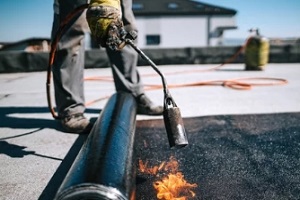 Delaware is a state with wide-ranging weather. Heavy snowfall in the winter gives way to bright sunshine and more than 45 inches of rain each year, and all of this moisture needs to go somewhere. Ideally, it seeps into the ground, where it can nourish plants and provide a lush, vibrant landscape.
Delaware is a state with wide-ranging weather. Heavy snowfall in the winter gives way to bright sunshine and more than 45 inches of rain each year, and all of this moisture needs to go somewhere. Ideally, it seeps into the ground, where it can nourish plants and provide a lush, vibrant landscape.
Unfortunately, commercial buildings that have not been properly waterproofed can also serve as a reservoir for Delaware’s moist climate, and the dampness can seep into the cracks and vulnerabilities of the building for years before evidence emerges. Once the damage is done, however, it can be difficult to repair and may impact business operations for an extended period.
Here is an overview of why waterproofing is essential during Delaware building construction, including why it is wise to waterproof during the construction process and what waterproofing looks like for commercial buildings.
Why Waterproof During Construction Instead of After?
Waterproofing can be done at any time during a building’s life cycle. However, the most advantageous time to tackle it is during the early construction phase. Once the foundational elements of the building are constructed (that is, the foundation and its supports), they become inaccessible as the rest of the structure is added on top.
Regaining access to the foundation later to keep water out is called sub-grade or below-grade waterproofing, and it is extremely difficult and expensive, because dirt and the surrounding materials must be removed in order to access the foundation.
Instead, invest in waterproofing before the foundation is covered. This ensures that the structural support of your building is impervious to the same long-term damage as a non-treated foundation. Waterproofing done on the outside of the foundation is the best barrier against moisture intrusion, though waterproofing can also be done on the inside for added protection.
Best Delaware Commercial Waterproofing Methods
Waterproofing is not a one-size-fits-all project. The type of building you are constructing, as well as the land on which it is being built, your budget, and more, will all impact the right waterproofing method for your commercial structure.
Those looking for a robust waterproofing option can invest in watertight concrete, which is an impermeable material that does not allow water penetration. Unlike other types of concrete, this building option is not treated on the outside. Instead, its own inherent matrix is constructed to keep out water, so the material itself is intrinsically waterproof from the inside out.
Those for whom concrete is not the right choice or who want to use a different approach can benefit from a number of potential waterproof films or membranes. These are applied to the surface of a material, where they bond with the molecular structure of the substance (e.g., concrete) to form a permeable seal.
While it might not sound great to have a “permeable” solution for waterproofing, it’s actually very important. This allows the water vapor inside a building to escape (instead of causing dampness and mold) while simultaneously keeping outside water from getting in.
The Risks of Lack of Waterproofing
When water seeps into a foundation, it may cause cracks through a repeating process called the freeze-thaw cycle. As Delaware’s temperatures fluctuate, the moisture freezes, expands, thaws, fills more of the gap, expands again, widens the gap, and repeats.
This leads to significant fracturing in the foundation that can cause lump floors or stuck doors at best and hazardous structural conditions at worst.
Failure to adequately waterproof can also result in long-term mold and mildew damage. When moisture finds its way into the dark, sheltered places of your building, it can fester and bring with it mold spores from outside.
Mold can be hazardous to human health, and your building can house hundreds or even thousands of square feet of mold without presenting evidence until the issue is severe enough to require costly professional remediation.
The dampness may also creep into the framing structures of the building, where it rots away wood and drywall, leading to unsightly messes and structural issues that may be expensive and time-consuming to repair. The repair process may also shut down your business for days or weeks, impacting productivity and slashing profits.
Get Your Delaware Commercial Waterproofing Done Right for Your Building
Waterproofing is one of the most essential elements of Delaware building construction, and it is best done during the early construction phases when the foundation is still accessible. If you would like to invest in commercial waterproofing to increase the longevity of your commercial structure, the experts at Waterproof Caulking & Restoration can help.
Whether you are in the midst of early construction or have already closed up your foundation, there is a waterproofing strategy that can work for you. Contact Waterproof Caulking & Restoration to discuss your options.
